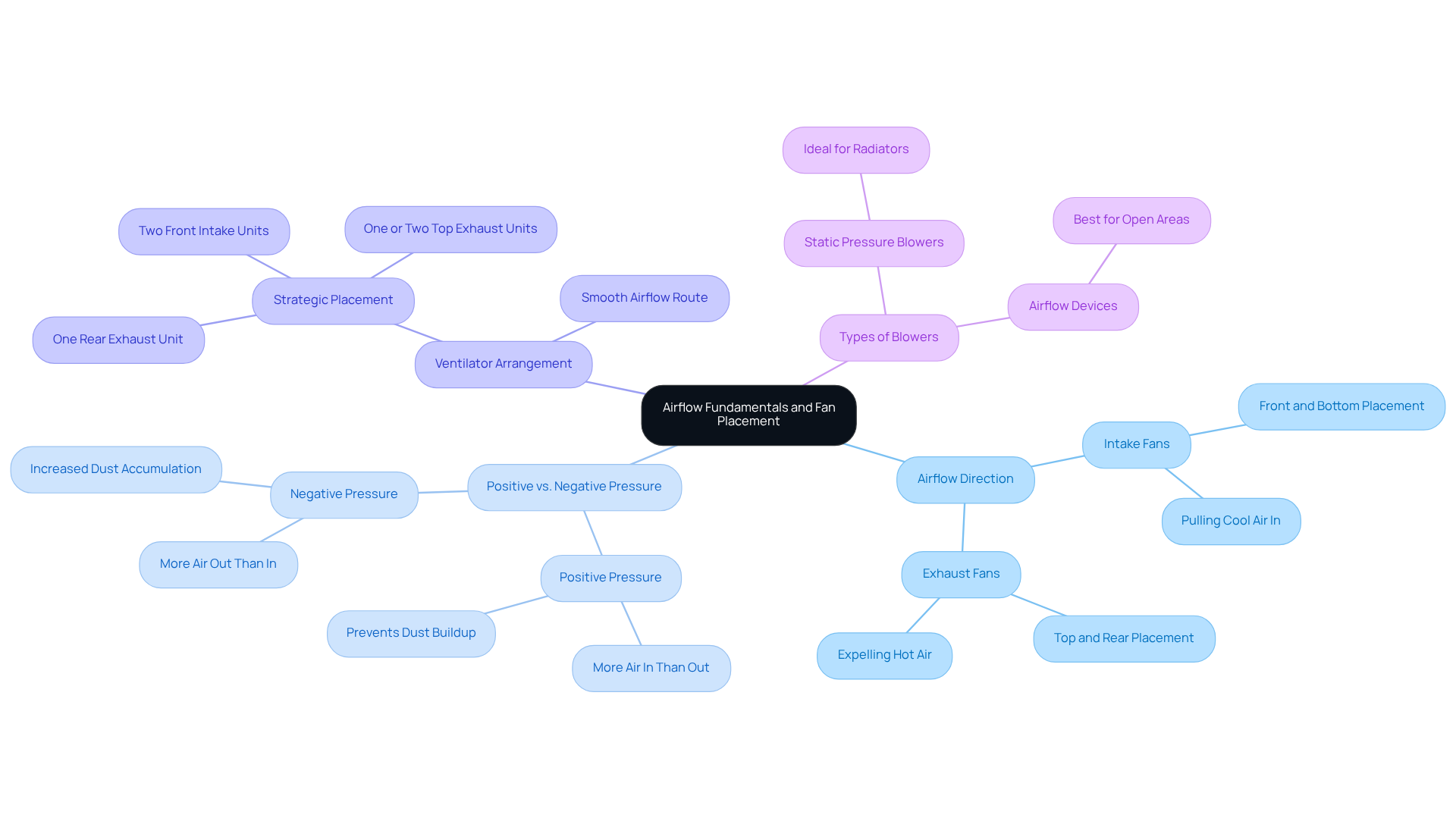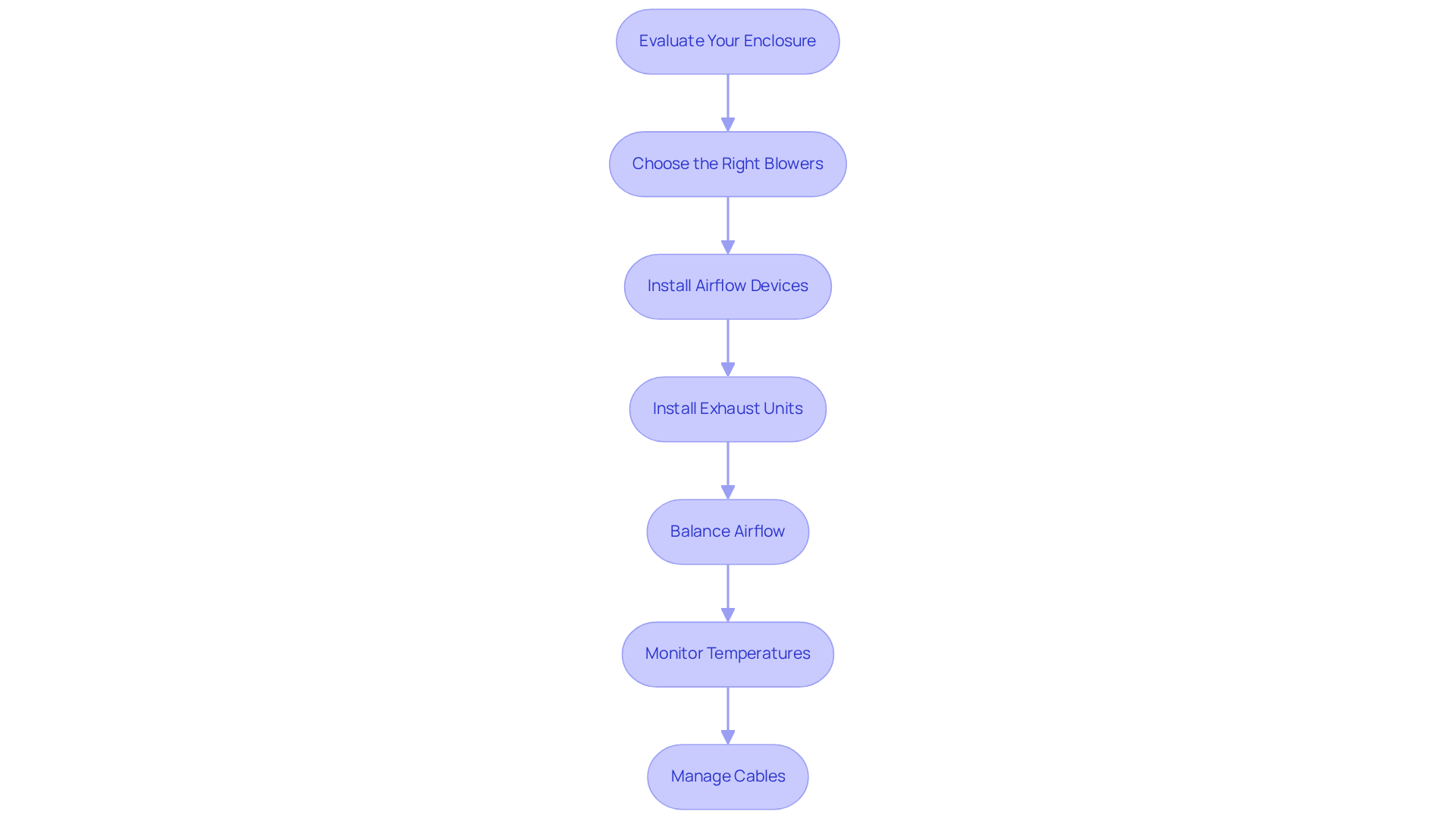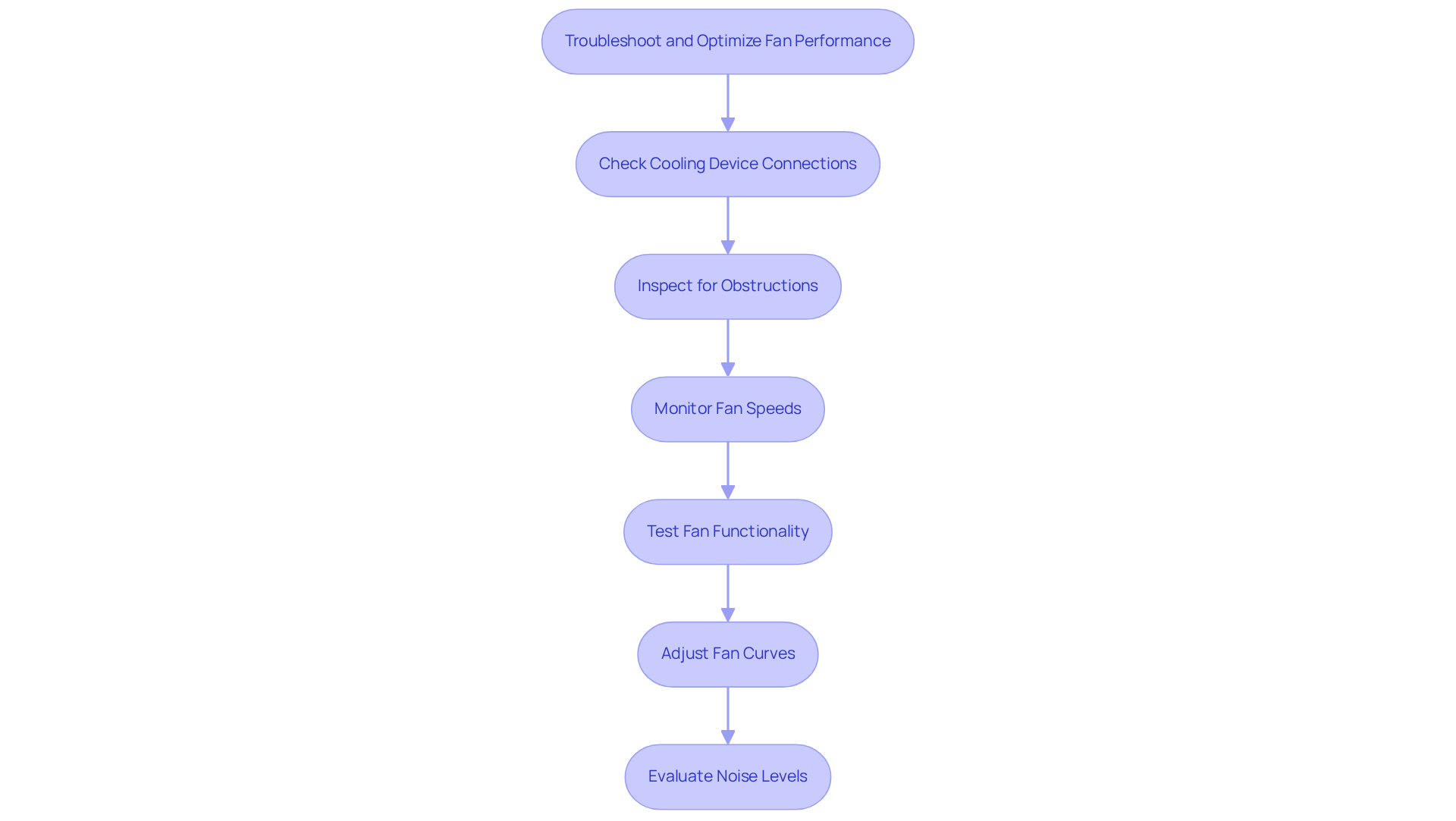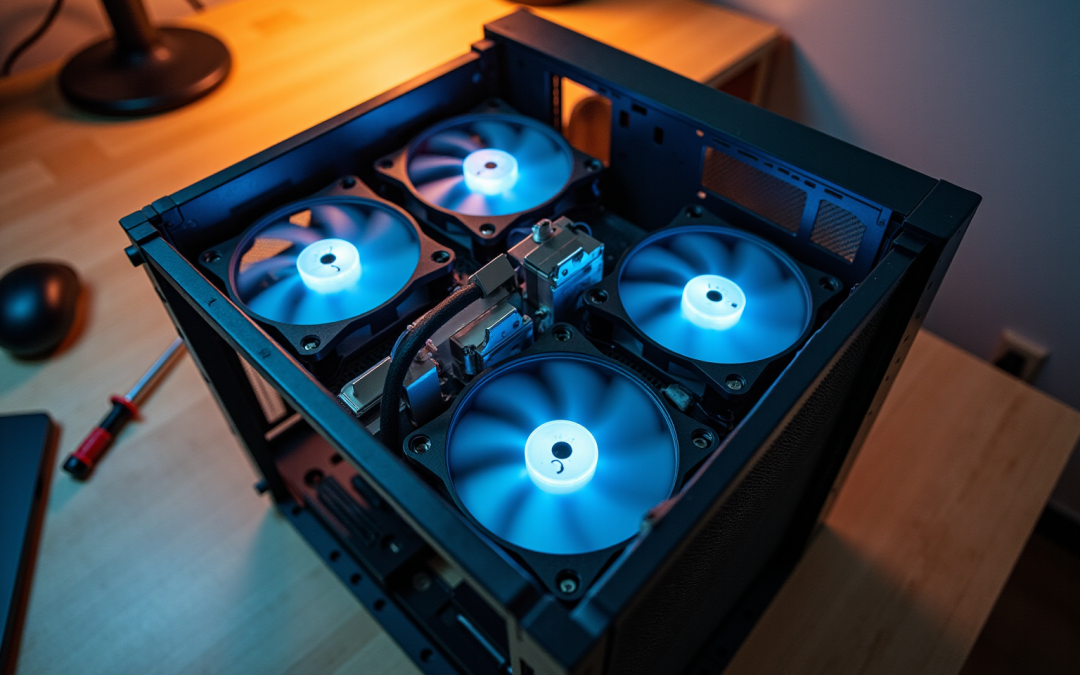Overview
To optimize cooling in a PC, understanding airflow fundamentals is paramount. This includes the strategic arrangement of intake and exhaust fans to create positive pressure, which significantly enhances cooling efficiency and minimizes dust accumulation. The article elaborates on techniques such as:
- The precise placement of fans
- Diligent temperature monitoring
- The maintenance of balanced airflow
These strategies are essential not only for sustaining optimal performance but also for prolonging the lifespan of computer components.
Introduction
Understanding the intricacies of PC fan flow is crucial; it can determine whether a system operates seamlessly or struggles under heat. As technology advances, the need for efficient cooling solutions escalates, making it essential for PC builders and enthusiasts to master the fundamentals of airflow and fan placement.
Many may wonder: how can one effectively configure their cooling system to enhance performance and prolong the lifespan of components?
This guide delves into optimizing PC fan flow, presenting expert techniques designed to transform any setup into a cooling powerhouse.
Understand Airflow Fundamentals and Fan Placement
To optimize cooling in your PC, understanding the fundamental principles of is crucial, as it is essential for dissipating heat generated by components. Here are key concepts to consider:
- Airflow Direction: Air typically flows from the front and bottom of the case to the back and top. Ensure that your intake fans, usually located at the front and bottom, effectively pull cool air in to optimize PC fan flow, while exhaust fans at the rear and top expel hot air out. Verifying fan orientation during assembly is essential, as improper installation can disturb the balance of air circulation.
- Positive vs. Negative Pressure: Positive pressure occurs when more air is pushed into the case than is exhausted, which helps prevent dust buildup and enhances cooling efficiency. In contrast, negative pressure can lead to dust accumulation as outside air is drawn in through unfiltered openings. Most builders recommend maintaining a slight positive pressure for optimal PC fan flow performance, as it helps push dust out through cracks or vents.
- Ventilator Arrangement: Arrange ventilators strategically to establish a smooth breeze route. For example, position intake vents at the front and bottom, and exhaust vents at the top and rear. This arrangement establishes an efficient airflow pattern that optimizes PC fan flow from front to back, which is ideal for most PC cases. A typical setup contains two front intake units, one rear exhaust unit, and one or two top exhaust units.
- Types of Blowers: Various blowers fulfill specific functions. Static pressure blowers are perfect for pushing air through dense regions like radiators, while airflow devices excel at moving air across open areas. Choosing the appropriate type of PC fan flow according to your temperature regulation requirements is crucial for enhancing efficiency. Gagner-Toomey Associates provides a wide range of DC input Tube Axial devices and Centrifugal Blowers, optimized for performance and low noise, ensuring you have the appropriate solution for your specific application. Their supporters vary in dimensions from 15mm to 280mm, accommodating different temperature management needs. Regular maintenance, including cleaning your PC every 1-3 months to prevent dust buildup, is also crucial for maintaining optimal airflow.
By grasping these fundamentals and leveraging Gagner-Toomey’s innovative cooling solutions, including their extensive range of thermal management products for electronics cooling, you will be better equipped to configure your PC’s cooling system effectively, ensuring longevity and optimal performance of your components.

Configure PC Case Fans for Positive Pressure and Efficiency
To configure your PC case fans for positive pressure and efficiency, follow these steps:
- Evaluate Your Enclosure: Begin by assessing the number of openings for cooling devices in your case and the dimensions of the units, typically 120mm or 140mm.
- Choose the Right Blowers: Select fans that balance airflow (measured in CFM) and static pressure. For a positive pressure configuration, ensure your intake fans have a higher CFM rating than your exhaust fans. Additionally, consider noise levels; quieter fans enhance the gaming experience. Experts note that larger fans can push the same amount of air as smaller ones at lower RPM, thereby reducing noise levels.
- Install Airflow Devices: Position at least two intake fans at the front of the enclosure. If possible, add one or two at the bottom, ensuring these fans are oriented to draw air into the case. Be aware that mesh panels can attract dust, but effective dust filters can help mitigate this issue.
- Install Exhaust Units: Place one or two exhaust fans at the top and one at the rear of the case, oriented to expel air.
- Balance Airflow: Strive for a slight imbalance where the total CFM of intake fans exceeds that of exhaust fans by approximately 10-20%. This creates positive pressure, which helps keep dust out and enhances temperature regulation. Cooling technology experts emphasize that maintaining a positive pressure environment is vital for optimal performance.
- Monitor Temperatures: After installation, use software tools to monitor system temperatures. Adjust fan speeds in the BIOS or through software to ensure optimal performance without excessive noise.
- Manage Cables: Effective cable management is essential for improving ventilation. Use cable ties to keep cables organized and clear of the airflow.
By following these steps, you can effectively configure the PC fan flow in your case to establish a positive pressure setting, enhancing thermal performance and prolonging the lifespan of your components. An effective cooling setup typically includes a combination of high-quality intake and exhaust fans that enhance PC fan flow, ensuring efficient airflow and minimal dust accumulation. The ideal configuration generally features three intake fans and one exhaust fan for optimal air cooling.

Troubleshoot and Optimize Fan Performance
To troubleshoot and optimize fan performance, consider the following steps:
- Check Cooling Device Connections: Ensure all cooling units are securely connected to the motherboard or controller. Loose connections can prevent motors from spinning or cause them to operate at reduced speeds.
- Inspect for Obstructions: Open your case and examine for any obstructions that may impede airflow, such as tangled cables or dust accumulation on fan blades. Use compressed air to that could hinder performance.
- Monitor Fan Speeds: Utilize software tools to track fan speeds and temperatures. If the cooling units are operating slower than anticipated, modify the speed curve in the BIOS or via software to enhance their velocity according to temperature limits. For instance, a fan curve with settings at 0°C – 30%, 60°C – 60%, and 80°C – 100% can help maintain optimal temperature control.
- Test Fan Functionality: If a fan is unresponsive, test it by connecting it to a different header on the motherboard. If it still fails to operate, the fan may be defective and require replacement.
- Adjust Fan Curves: Configure custom fan curves in the BIOS or via software to enhance performance. A suggested method is to adjust ventilators to function at reduced speeds during inactive times and increase as temperatures escalate, ensuring effective temperature regulation. Remember, a PWM duty cycle of 100% indicates full speed, which is crucial during high-load scenarios.
- Evaluate Noise Levels: If fans produce excessive noise, consider replacing them with quieter models or modifying the fan curve to lower speeds during low-load scenarios. As noted by a user, “Lowering the base speed at idle, and making the ramp up more gradual can have a drastic effect not only on noise levels, but temperature as well.”
By applying these troubleshooting measures, you can enhance PC fan flow, which ensures efficient temperature regulation for your PC components. Remember, maintaining a slightly positive case pressure is generally recommended to enhance airflow efficiency, as it helps prevent dust accumulation while promoting better cooling performance.

Conclusion
Optimizing PC fan flow is crucial for maintaining an efficient cooling system and extending the lifespan of your components. Understanding the principles of airflow, configuring fans for positive pressure, and troubleshooting performance issues can significantly enhance your PC’s cooling efficiency. Proper fan placement and airflow management not only regulate temperatures but also minimize dust accumulation, ensuring a cleaner and more effective environment for your hardware.
Key techniques include:
- Evaluating airflow direction
- Selecting the right fans based on static pressure and airflow ratings
- Implementing a balanced fan configuration with a slight positive pressure
Regular maintenance, such as cleaning and monitoring fan speeds, plays a vital role in sustaining optimal performance. These insights are essential for anyone looking to improve their PC cooling setup, whether for gaming, content creation, or general use.
Ultimately, mastering PC fan flow is a worthwhile investment that yields improved performance and longevity of your system. By embracing these expert techniques, you enhance your PC’s cooling capabilities and create a more efficient and enjoyable computing experience. Implement these strategies today and witness the difference in your PC’s performance and reliability.
Frequently Asked Questions
Why is understanding airflow fundamentals important for a PC?
Understanding airflow fundamentals is crucial for optimizing cooling in a PC, as it helps dissipate heat generated by components, ensuring efficient performance and longevity.
What is the typical airflow direction in a PC case?
Air typically flows from the front and bottom of the case to the back and top. Intake fans are usually located at the front and bottom to pull cool air in, while exhaust fans at the rear and top expel hot air out.
What is the difference between positive and negative pressure in a PC?
Positive pressure occurs when more air is pushed into the case than is exhausted, helping to prevent dust buildup and enhance cooling efficiency. Negative pressure, on the other hand, can lead to dust accumulation as outside air is drawn in through unfiltered openings.
What is the recommended pressure setup for optimal PC fan flow performance?
Most builders recommend maintaining a slight positive pressure for optimal PC fan flow performance, as it helps push dust out through cracks or vents.
How should ventilators be arranged for effective airflow?
Ventilators should be arranged with intake vents at the front and bottom and exhaust vents at the top and rear. This creates an efficient airflow pattern from front to back, which is ideal for most PC cases.
What is a typical fan setup for a PC?
A typical fan setup includes two front intake units, one rear exhaust unit, and one or two top exhaust units.
What types of blowers are available for PC cooling?
There are various types of blowers, including static pressure blowers, which are ideal for pushing air through dense regions like radiators, and airflow devices, which excel at moving air across open areas.
Why is regular maintenance important for PC airflow?
Regular maintenance, including cleaning your PC every 1-3 months, is crucial for preventing dust buildup, which can obstruct airflow and reduce cooling efficiency.
What solutions does Gagner-Toomey Associates provide for PC cooling?
Gagner-Toomey Associates offers a wide range of DC input Tube Axial devices and Centrifugal Blowers optimized for performance and low noise, along with various thermal management products for electronics cooling.

